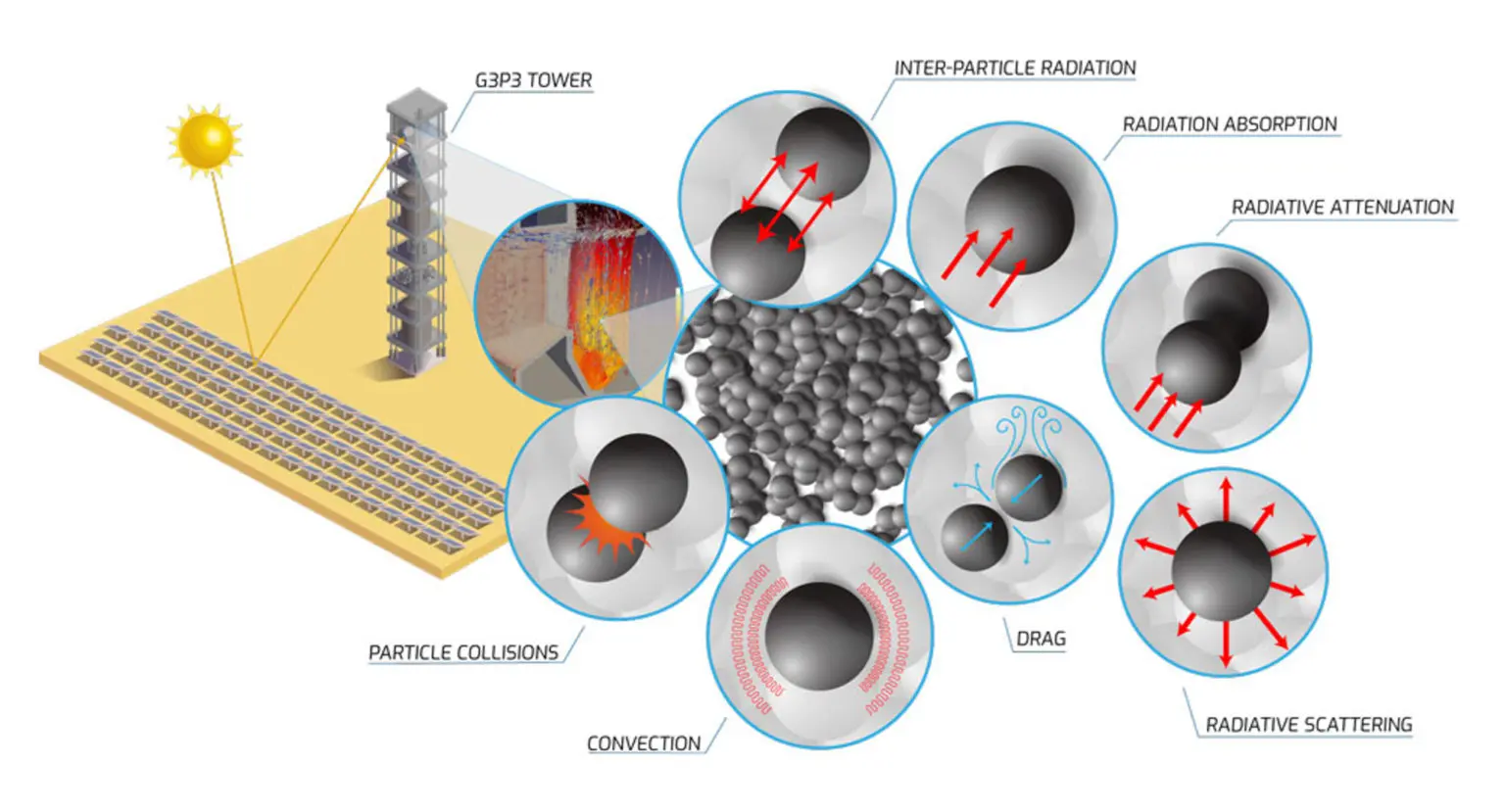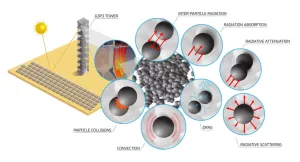Sandia Labs is building a concentrated solar power demonstration facility that is scheduled for completion in 2024.
Remember when a camp counselor showed you how to use a magnifying glass to burn your name onto a piece of wood? That’s essentially what concentrated solar power or CSP does. An array of mirrors spread across a wide area focus sunlight on a single spot. Where the sunlight converges, temperatures can reach 800º C or more. That heat can then be used to create superheated gases — steam or carbon dioxide, usually — to spin generators that make electricity.
That’s if the sun is shining. But what happens when the sun sets? Is there some way to store that free heat so it could be used later? That’s a question researchers at Sandia National Laboratory have been working to answer since 2017. It sounds simple — heat something up now then use that heat later. But what is that something? And what challenges have to be overcome in order to store that something at such high temperatures safely?
Sandia Concentrated Solar Power Research
In 2018, Sandia created three research teams and turned them loose to find the answers. Their mission was to determine whether liquid, solid, or gaseous materials were best for heat storage at temperatures of 700º C or higher from both an efficiency and a safety perspective. CSP plant operating temperatures greater than 700° Celsius have the potential to reduce the cost of CSP systems by increasing the efficiency of the facility. In March of 2021, the Department of Energy announced that solid particles provided the most promising pathway to achieving higher temperatures in CSP plants to reduce the cost of concentrated solar power to 5 cents per kwh by 2030.
This week, the Department of Energy held a groundbreaking ceremony at Sandia Labs for a CSP demonstration facility that will use its latest Gen 3 technology. The design goal for the plant is 1 gigawatt-hour (GWh) of energy storage. “Next-generation CSP has the potential to be a game-changer,” said Alejandro Moreno, the acting assistant secretary for energy efficiency and renewable energy. “This pilot facility will demonstrate how CSP systems can meet the challenges of providing long duration energy storage while reducing costs and complexity for solar thermal technology. At the same time, it also provides a pathway to commercialization for industrial process heat.”
Most concentrated solar power plants today use molten salt as the heat storage medium and operate at around 560º C. Facilities that operate at higher temperatures are more efficient, which translates into lower electricity prices. According to a Sandia Labs press release, the new facility will use a sand-like material composed of ceramic bauxite particles. They will be released at the top of a tower system, where gravity pulls them through a so-called falling particle receiver (FPR). On their way to the ground, they pass through a beam of concentrated sunlight that heats them.

The heated particles can be stored for future use when the sun is not shining or be used immediately in conjunction with a highly efficient supercritical-CO2 Brayton cycle to generate electricity. The particles are then lifted to the top of the tower to be dropped into the FPR to be reheated. The biggest advantage of these particles is they can reach very high temperatures (>800°C) whereas traditional CSP heat transfer mediums cannot. This allows use of the efficient supercritical CO2 cycle, which makes generating electricity much cheaper.
Free Doesn’t Mean Easy
Think all this is easy? Think again, Sandia spent tens of thousands of hours on the computer simulations needed to understand how the FPR operated and account for variable factors such as weather. This information was compiled to create a detailed view of yearly receiver performance and to develop key data points for evaluating feasibility.
“The simulations help us maximize the amount of sunlight the particles absorb where small changes in the geometry, operating conditions, or environment can affect that absorption,” says researcher Brantley Mills. “The less energy the particles absorb, the lower the efficiency and the more expensive it is to generate electricity. These models are helping us identify and minimize all the thermal losses that may contribute to lower efficiency.”
All that modeling and simulation have resulted in a receiver design that will be integrated into the Generation 3 Particle Pilot Plant (G3P3) tower, which is expected to become operational in 2024. The completed facility will be a fully integrated particle pilot plant that can help answer questions about the integration and scaling of this technology. If successful, the technology will be scaled up to plant sizes as large as 100 MW with the ability to store energy for later use when sunlight is not available.
High Temperature Concentrated Solar Power Creates Engineering Challenges
As we reported in 2018, the high temperatures associated with CSP facilities can lead to challenges downstream. Heat exchangers transfer the heat in the storage medium to the superheated carbon dioxide that turns the generators. Currently, those heat exchangers are made of stainless steel or nickel-based alloys but they get too soft at higher temperatures and at the elevated pressure of supercritical carbon dioxide. Researchers at Georgia Institute of Technology, the University of Wisconsin – Madison, and Oak Ridge National Laboratory have developed new materials that can be used in make heat exchangers that operate reliably at those higher temperatures and pressures.
The researchers looked at the materials used to make nozzles for solid fuel rocket engines and created new heat exchangers made from zirconium carbide and tungsten that can withstand the high temperature, high pressure conditions supercritical carbon dioxide needs to generate electricity more efficiently. An economic analysis by Georgia Tech and Purdue researchers also showed that the scaled up manufacturing of these heat exchangers could be conducted at comparable or lower cost than for stainless steel or nickel alloy-based units.
The Takeaway
Energy from the sun is free. All we have to do is figure out how to harness it effectively. That second part is not quite as easy as the first, as the work at Sandia Lab on concentrated solar power makes clear. CSP may be part of the tool kit of renewable energy resources the world will need to break our reliance on fossil fuels to generate the electricity we rely on to power all the devices we have come to rely on.
Sandia Labs says that if the demonstration facility proves successful, it could point the way to concentrated solar power plants capable of providing 100 megawatts of electricity continuously, 24 hours a day, at very low cost. CSP plants could be especially valuable for bringing electricity to remote areas not served by a traditional utility grid. That would be good news for humanity and the environment.



